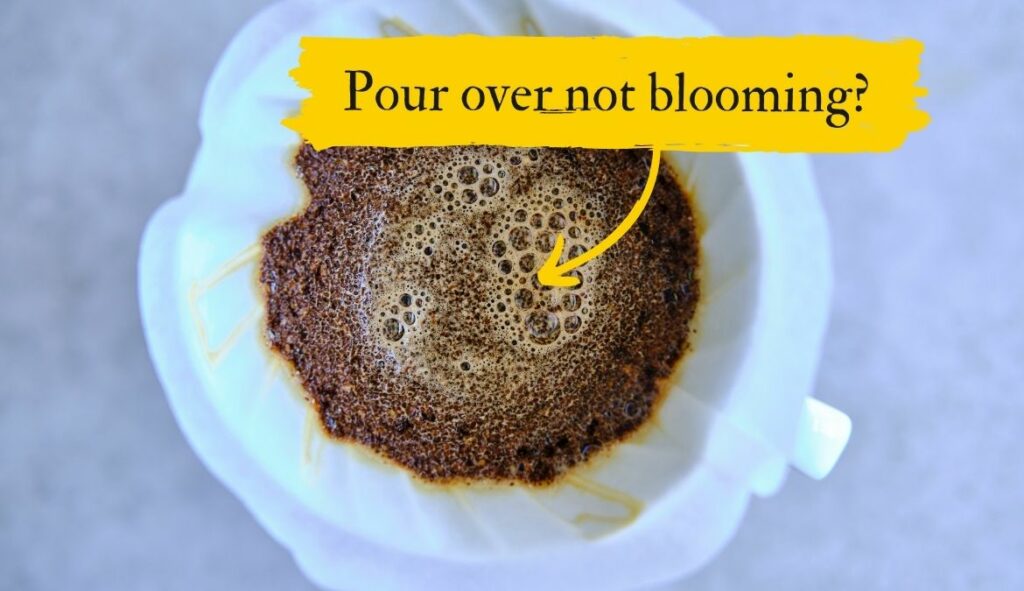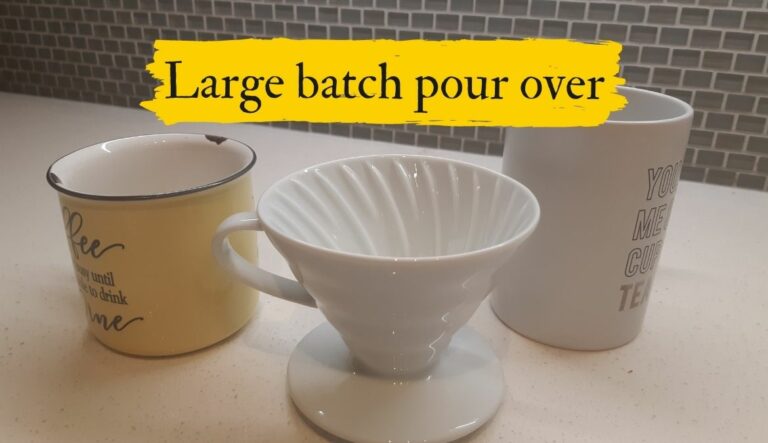The bloom is an important step when preparing pour over coffee. It degasses carbon dioxide so the coffee doesn’t taste sour and so that the water can effectively dissolve organic coffee compounds.
But have you ever noticed that your pour over coffee simply doesn’t bubble up and bloom? This article explains why this is happening and how you can fix it.

Why does my pour over coffee not bloom?
Pour over coffee stops blooming when the beans have been depleted of carbon dioxide (CO2) and gone stale. This happens when roasted coffee beans come into contact with oxygen. It occurs more quickly in pre-ground coffee or in roasted coffee that is more than 5 weeks old.
Stale coffee beans will not bloom as effectively
A coffee is considered stale when it has lost its CO2, aroma and flavor compounds. It’s unlikely that a brewed coffee will taste like nothing. However, stale coffee will lose many of the pleasant tastes that producers and roasters work hard to feature.
The staling process occurs as soon as coffee beans are roasted. Slowly, your coffee will produce a smaller bloom as its CO2 concentration lowers due to oxidation.
If your coffee does not bloom at all then it’s a strong indication that your coffee is old. You can still brew it but it likely won’t take as good as it once did.
Where do coffee aromas and flavors come from?
According to a study by Dulsat-Serra, et al. (2014) from Food Research International, coffee beans get many of their aromas and flavors from organic compounds called thiols[1]. These compounds are responsible for the roasted and “coffee-like” flavors we enjoy.
Part of the reason coffee is such a potent smell is because thiols have a low odor threshold, which means just a small concentration is detectable to human smell.
The concentration of thiols in our coffee depends on the degree of roasting, coffee variety and origin.
What happens to these thiols when coffee goes stale?
Thiols are prone to oxidation. This means that their chemical composition is changed in the presence of oxygen.
Oxygen, a strong oxidizing agent, attracts electrons from a reducing agent, the coffee thiols in this case. This causes the thiols to transform into a new compound that no longer provides the pleasant aromas and flavors, leaving us with a dull and empty tasting coffee.
This oxidation process begins immediately after coffee is roasted.
Pre-ground coffee stales more quickly
Oxidation occurs when a coffee bean is in contact with oxygen. Therefore, a greater contact surface area will cause a coffee bean to oxidize, and stale, more quickly.
This is why pre-ground coffee bought from a grocery store is usually stale and unlikely to bloom. The chemical compounds that bubble up and react with hot water are no longer present because they have been oxidized.
In addition to oxidation, the grinding process releases CO2 that is trapped inside the bean.
Light roast coffee will not bloom as much as dark roast coffee
Darker roasted coffee will bloom more effectively than light roast coffee because it contains a higher concentration of CO2.
A study from Wang & Lim (2014) discovered that dark roast coffee beans have approximately 37% more CO2 than medium roast beans and 240% more than light roast beans[3].

The roasting process causes CO2 to build in the pores inside the beans. This excess CO2 is released when hot water is added during the bloom when preparing coffee.
How to get your pour over coffee to bloom
You can achieve a bigger pour over bloom by using freshly roasted beans, buying beans grown at a higher-altitude, using a darker roast and grinding your coffee fresh before each brew. This will maximize the CO2 concentration that causes coffee to bloom.
Use freshly roasted beans
Freshly roasted beans will have a higher concentration of CO2 because it has not had enough time to fully degas. In other words, the beans have not had contact with oxygen for a long enough duration for the gas exchange to completely remove all CO2 from the bean.
This means your pour over coffee should have some level of bloom.
Buy coffee grown at a higher altitude
It is believed that higher density coffee beans make it more difficult for CO2 to escape. This means that a denser bean will have a bigger bloom than soft beans.
Beans grow more dense at higher altitudes because the coffee plant grows more slowly and causes the fruit and seeds (coffee beans) to have a higher density.
Coffee grown at an altitude of 4,000-4,500 feet (1,219-1,371 meters) is classified as being a hard bean (HB). Anything grown above 4,500 feet (1,371 meters) is considered a strictly hard bean (SHB).

Specialty coffee will advertise the altitude or range of altitudes your coffee was grown at. Ethiopia has an environment that is optimal for growing beans above 2,000 meters above sea level (MASL), which makes them a great candidate for producing a robust pour over bloom.
However, high-altitude beans are often sought after for their unique and nuanced flavours and are often roasted on the lighter side. Regardless, a fresh high-altitude bean will likely help you achieve a better pour over bloom.
Use a darker roast
Darker roasted coffee will contain a higher concentration of CO2 build up. The temperature and roasting process causes the beans to expand and fill with CO2.
Grind your coffee fresh before each brew
Coffee loses an abundance of its CO2 when it’s ground. Breaking the bean into pieces releases trapped CO2 much more easily than in its whole bean form.

Also, it increases the surface area of the bean to allow for oxidation to occur more quickly. We highly recommend investing in a high quality burr grinder and to start freshly grinding your beans before each brew.
This is one of the biggest specialty coffee tips you will learn for brewing the tastiest cup of coffee. It will also dramatically increase your success at achieving a good bloom.
Store your coffee in airtight packaging, a freezer or under nitrogen
Degassing occurs in all coffee over time, regardless of how it is packaged and stored. However, a study from the Faculty of Food Technology and Biotechnology at the University of Zagreb discovered that coffee preserved more of its volatile compounds when stored in airtight laminate in a freezer[2].
The second best option was to store it in a modified atmosphere full of nitrogen, which is free of oxygen.
How long should you let pour over coffee bloom?
35-45 seconds is an optimal range to allow your pour over coffee to bloom. This will give the beans a sufficient amount of time to offgas excess carbon dioxide that was previously trapped inside.
How much water do you use for blooming coffee?
It is best to bloom a pour over coffee with approximately twice as much water than there is ground coffee. For example, 22g of coffee would require about 44g (or mililiters) of water for the bloom. This will provide enough water to successfully degas the coffee grounds but not enough to trap CO2 beneath the weight of the water.
References
- Dulsat-Serra, N., Quintanilla-Casas, B., & Vichi, S. (2016). Volatile thiols in coffee: A review on their formation, degradation, assessment and influence on coffee sensory quality. Food Research International, 89, 982-988.
- Marin, K., Požrl, T., Zlatić, E., & Plestenjak, A. (2008). A new aroma index to determine the aroma quality of roasted and ground coffee during storage. Food Technology and Biotechnology, 46(4), 442-447.
- Wang, X., & Lim, L. T. (2014). Effect of roasting conditions on carbon dioxide degassing behavior in coffee. Food research international, 61, 144-151.






